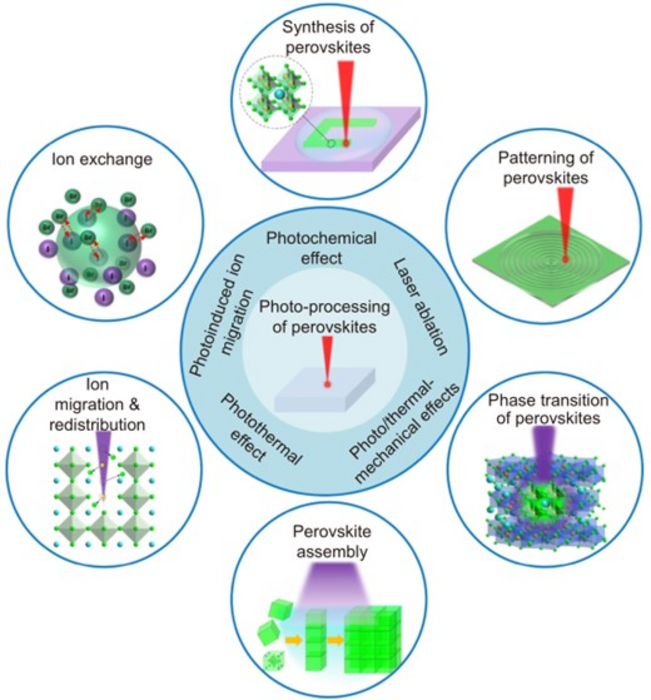Considerable advancement has been witnessed in the development of semiconducting metal-halide perovskites (MHPs) for the past 20 years.

Schematic overview of the current research on the photo-processing of perovskites. Image Credit: OES
The outstanding optoelectronic properties and device performance make perovskites highly desirable in several fields. Photo-processing has been illustrated to be an easy method for synthesizing perovskites, altering their structures, and creating patterns and devices.
As human civilization experiences the information revolution, the desire of scientists to use next-generation semiconductor materials with outstanding optoelectronic properties has considerably increased.
The past few years have seen an increasing interest in metal-halide perovskites as a result of their optoelectronic properties. This consists of a considerable tunable band gap, absorption coefficient, low exciton binding energy, long carrier diffusion length, and high defect tolerance.
Metal-halide perovskites exhibit good performance in diverse optoelectronic and photovoltaic devices and applications.
As a result of the low formation energy and ionic crystal structure of metal-halide perovskite, photo-processing could be applied as a high-throughput, easy, and chemically clean technique of synthesizing, altering structures, and patterning.
Moreover, the high mobility of ions (halide ions) provides a special possibility for the photo-processing of perovskites. It has the potential to induce several effects, like photo-processing of perovskites for synthesis, ion exchange, phase transition, patterning, assembly, and ion migration and redistribution.
A highly explorative direction for the phenomena and mechanisms of photo-processing will streamline the control of the optoelectronic properties of perovskite materials.
Photo processing has been fixed as a strong method for structure modification, material synthesis, and patterning in semiconductor science and technology.
In comparison to other standard processing techniques, photo-processing exhibits various advantages including compatibility with flexible substrates, high area selectivity, and high scalability.
More significantly, direct laser writing is an easy mask-free lithography method to make patterns. This is crucial for the fabrication of micro-optoelectronic devices.
Photo-processing has the potential to induce several effects on the perovskites and the performance of the device. Light irradiation could induce the severe generation of defects, degradation of the perovskites, and phase segregation in mixed-halide perovskites.
It has the potential to result in a decrease in the device performance and greatly inhibit the perovskites’ application. On the other hand, light irradiation can also play a vital and so-called “positive” role in the formation and patterning of perovskites. This alters the structures, tuning the optoelectronic properties and enhancing the device’s performance.
Light irradiation has the potential to induce the generation of perovskites in films, solutions, and transparent solids. It can allow controlling ion distribution in the perovskites for the bandgap to be tuned.
Photo processing has emerged as a strong method for the structure and synthesis modification of perovskites. In this study performed, the authors have a discussion regarding the mechanisms of photo-processing of perovskites and outline the recent advances in the photo-processing of perovskites. This can be done for patterning, ion exchange, synthesis, assembly, phase transition, and ion migration and redistribution.
The applications available in photo-processed perovskites in lasers, light-emitting diodes (LEDs), photovoltaic devices, photodetectors, and optical data storage and encryption are also discussed. Eventually, the authors offer an outlook on the photo-processing of perovskites and suggest promising directions for research to be conducted in the future.
Moreover, the authors recommend that the normal principles of the photo-processing methods, like the photothermal effect, photochemical effect, and laser ablation are also compared to other NCs or quantum dots that come with controlled light sources and precursors.
Consequently, the discussions happening in this work will be generally significant for the photo-processing of quantum dots or several NCs.
Journal Reference:
DZ, T., et al. (2022) Photo-processing of perovskites: current research status and challenges. Opto-Electronic Science. https://doi.org/10.29026/oes.2022.220014.